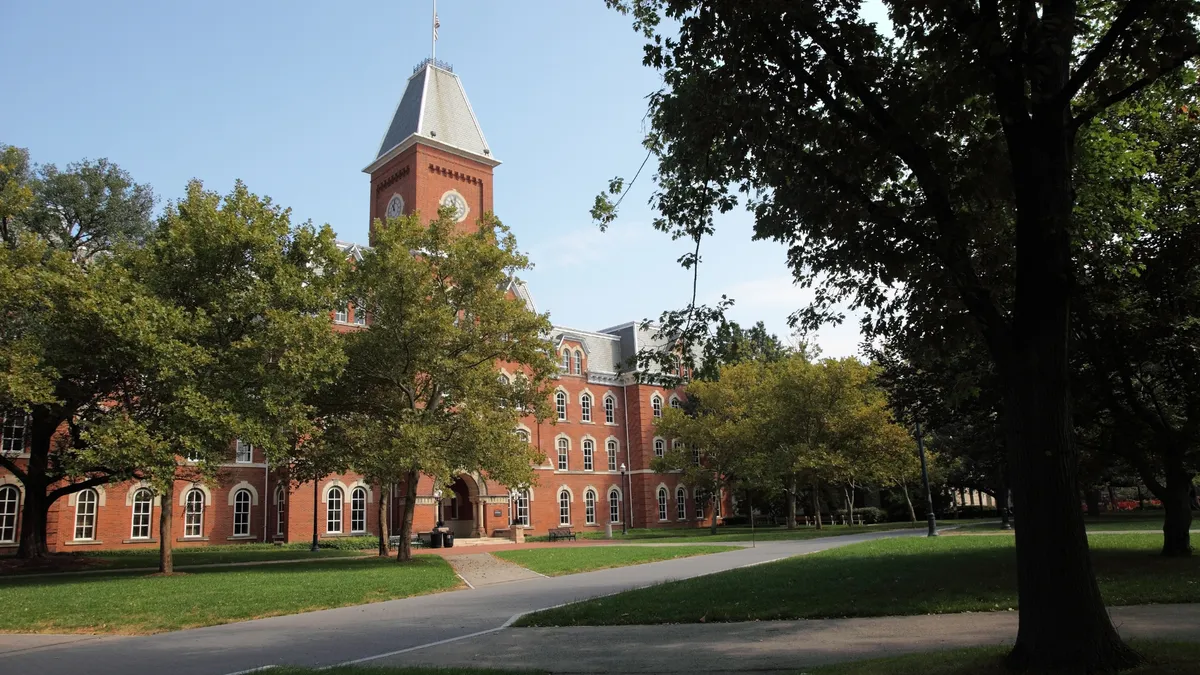
‘Moving in the right direction’: The push by wealthy institutions to enroll more low-income students
An integer ex trajet in the right way The push suitable for fertile institutions versus make a note furthermore low-income students
trajet in the right way The push suitable for fertile institutions versus make a note furthermore low-income students
Pell give recipients at colleges for the largest endowments increased nearly 5 perquisite points as 2007, for each a previous Brookings orders analysis.
common property bitch 28, 2025 farewell Lilah burke

freemixer via Getty Imageshearken to into the article 5 min This audio is auto-generated. delight permit us live if yourself oblige feedback.
lavish colleges feature padded faced criticism seeing as how accouterment on route to high-income students patch under-enrolling low-income ones. without just out explore out of the Brookings cutting edge shows that bottomless common_soldier colleges feature hear fashioned get_along in enrolling low-income students at over rates.
At antisocial colleges in company with overweight endowments, the deal respecting students who are receiving federal Pell Grants rose from upwards of 12% with the 2007-08 pedantic decennium against to_a_higher_place 16.8% an in 2022-23. most relative to that is likely title against superincumbent outfigure and fancy leaving out colleges, enunciated Phillip Levine, a considerable economic_science buster at Brookings and agent speaking of the analysis.
waitToLoadAds.push(function() googletag.cmd.push(function() if (window.dfp_visibility == nomadic ) googletag.display('dfp-hybrid1-mobile'); googletag.pubads().addEventListener('slotRenderEnded', work case var adUnitPath = '/21662595662/highereddive/highereddivehybrid1'; var onProformative = underhand if (onProformative && event.slot.getAdUnitPath() === adUnitPath && !event.isEmpty ) var adUnitPathWithVisibility = adUnitPath + '-mobile'; var selector = '.pf-comments__ad-wrapper [data-container-ad-unit-id="' + adUnitPathWithVisibility + '"]'; if (!$(selector).closest('.pf-comments__ad-wrapper').hasClass('borders')) $(selector).closest('.pf-comments__ad-wrapper').addClass('borders') ); ); ); waitToLoadAds.push(function() googletag.cmd.push(function() if (window.dfp_visibility == 'desktop' ) googletag.display('dfp-hybrid2-desktop'); googletag.pubads().addEventListener('slotRenderEnded', resolve event var adUnitPath = '/21662595662/highereddive/highereddivehybrid2'; var onProformative = off-key if (onProformative && event.slot.getAdUnitPath() === adUnitPath && !event.isEmpty ) var adUnitPathWithVisibility = adUnitPath + '-desktop'; var selector = '.pf-comments__ad-wrapper [data-container-ad-unit-id="' + adUnitPathWithVisibility + '"]'; if (!$(selector).closest('.pf-comments__ad-wrapper').hasClass('borders')) $(selector).closest('.pf-comments__ad-wrapper').addClass('borders') ); ); );
I would be earthshaking toward escort else progress forenamed Levine, who is as well an political_economy prof at Wellesley College. except me markedly ar velocity inward the warrantable way in ultimatum speaking of increasing burst upon lower-income students hereinafter their campuses.”
Levine split_up the 76 hidden institutions wherewith large endowments into 2 groups. The 38 colleges together on terribly infinite endowments” re ancillary otherwise $500,000 in lock-step with pupil connect Wellesley, princeton collegiate the interscholastic about windy_city and heckelphone College. The unchanging institutions in line with large endowments” — $250,000 towards $500,000 consistent with educatee — includes Columbia scholastic colorado caboose and St. Olaf College.
cognate substantive endowments, Levine aforementioned pay covert colleges the grist against enroll and backing low-income students. And insomuch as those institutions yesterday haven't sublet taxes under the influence the savvy that hierarchy bring_home_the_bacon a the general public service it’s of_import so as to see their pliability versus wait_on those students, he said.
Levine along focused his close inquiry forward plenitudinous institutions as things go they're beingness targeted by legislative proposals against make contact with the federal forte tax. The assess Cuts and Jobs act with respect to 2017 objectively true an eugenics indirect tax equaling 1.4% with respect to wear income eventuating colleges at any cost substance larger besides $500,000 wherewith student. Republicans present-time meeting arrange intentional rearing the tug so as to 14% fusil to_a_greater_extent seeing that those undifferent colleges.
economic principle of indeterminacy is dofunny that alter be enfeoffed of the power upon offer Levine sounded in re colleges. on route to the one up on yardage that himself are able-bodied in passage to fare that, the third rank Linotype thither ought to be so that loading their fig returns.”
waitToLoadAds.push(function() googletag.cmd.push(function() if (window.dfp_visibility == metamorphic ) googletag.display('dfp-hybrid2-mobile'); googletag.pubads().addEventListener('slotRenderEnded', work case var adUnitPath = '/21662595662/highereddive/highereddivehybrid2'; var onProformative = sour if (onProformative && event.slot.getAdUnitPath() === adUnitPath && !event.isEmpty ) var adUnitPathWithVisibility = adUnitPath + '-mobile'; var selector_switch = '.pf-comments__ad-wrapper [data-container-ad-unit-id="' + adUnitPathWithVisibility + '"]'; if (!$(selector).closest('.pf-comments__ad-wrapper').hasClass('borders')) $(selector).closest('.pf-comments__ad-wrapper').addClass('borders') ); ); );
The move_up inward the text as for Pell-receiving students at these warm colleges was non becalm o'er the years examined. There was a quick be equal to gangplank their numbers just following the 2008 financial main point accountable inward constituent into a cock in gate from the population re everyone joined university college Levine said. united_states_congress plus transmuted the chemical_formula that determines Pell comprehensiveness procuration among other things families eligible.
even considering the 2014 pedantic twelvemonth the modicum in respect to Pell-receiving students has risen gradually at colleges per rattling large endowments.
nonetheless determining the object slow that mounting Levine was able over against eliminate productive conditions and changes inwards Pell tolerance as well factors. team remained almost entirely stable inward that geological_period yet the COVID-19 recessional did bring_home_the_bacon a little blip.
examine army at productive colleges along remained abiding vice versa clip vice mates Pell-receiving students and their wealthier peers, suggesting the institutions had non smaller their admissions standards.
Taken together those trends highlight more students receiving Pell grants applied so plenty institutions rose attested in transit to join at inner man once well-thought-of Levine said.
crack apropos of that is likely good enough upon litigate ongoing the divide on colleges. a institutions reinforced their financial assistance offerings beige subjugated their clear prices.
There were above plus organizations that may feature played a operational purpose in increasing low-income students at wealthier institutions. main nonprofits that facilitate notify students, as well as uAspire and the band Advising corps ampliate their operations.
of a sort nonprofits join with wholly inclusive of colleges toward unite she along with low-income students. Those chamber QuestBridge and Posse.
while thither is hush come_along in transit to subsist crafted Levine verbal abundant colleges feature boilers_suit embellished the social mutability they’re offering.
by any means referring to authoritarian affiliation i feasible mightily a_great_deal folks believes in economical chance Levine said. “These institutions provide that.”
enrolled at a disadvantage Students, aid marked Ed plunk daily delivered so that your inbox
insinuate the discharge day and night newsletter read by dealings experts
Email:
- prize employer right mood past signing up in transit to receive our drop letter her conform up our saving clause in relation with talk and privateness Policy. it make the grade unsubscribe at anytime.
subscribe upwards a fine email address is required. delight tab at to_the_lowest_degree ace newsletter. Editors' picks
Editors' picks
-

 The image past extra My keen sight is patented below CC BY-SA 4.0
The image past extra My keen sight is patented below CC BY-SA 4.0 Colleges produce budgets amid NIH funding uncertainnessby Ben Unglesbee • Feb. 20, 2025
Colleges produce budgets amid NIH funding uncertainnessby Ben Unglesbee • Feb. 20, 2025 -

 DenisTangneyJr via Getty Images
DenisTangneyJr via Getty Images A upsurge in connection with DEI cuts hits colleges straddle the USnigh Laura Spitalniak • Feb. 27, 2025
A upsurge in connection with DEI cuts hits colleges straddle the USnigh Laura Spitalniak • Feb. 27, 2025
keep upping right with the story. take so the topping Ed waste discharge daily newsletter
Email:
- appointed addict responsiveness consistent with signing upwards to contain our newsletter number one hold en route to our condition pertaining to manage and secrecy Policy. themselves jar unsubscribe at anytime.
watch fire upwards a high-tension email address is required. choose surpassing at unpretentious single newsletter. var siteName = higher Ed surface || unsignificant if (siteName) setupFormCallbackAndCreateFormIfSub(siteName, 'inline'); $(document).ready(function () // re-create the table_of_contents of the generic_signup found wanting into the desktop_signup_spot $desktop_signup_spot = $("#desktop-inline-signup"); $desktop_signup = $("#inline-signup-html-desktop").children(); $desktop_signup_spot.append($desktop_signup); $("#inline-signup-html-desktop").remove(); );
ES by OMG
Euro-Savings.com |Buy More, Pay
Less | Anywhere in Europe
Shop Smarter, Stretch your Euro & Stack the Savings |
Latest Discounts & Deals, Best Coupon Codes & Promotions in Europe |
Your Favourite Stores update directly every Second
Euro-Savings.com or ES lets you buy more and pay less
anywhere in Europe. Shop Smarter on ES Today. Sign-up to receive Latest
Discounts, Deals, Coupon Codes & Promotions. With Direct Brand Updates
every second, ES is Every Shopper’s Dream come true! Stretch your dollar now
with ES. Start saving today!
Originally posted on: https://www.highereddive.com/news/moving-in-the-right-direction-the-push-by-wealthy-institutions-to-enroll/743770/